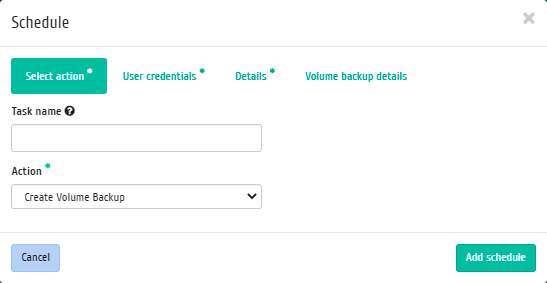«Volumes» tab¶
Tab displays information about the status of block storage resources (volumes).
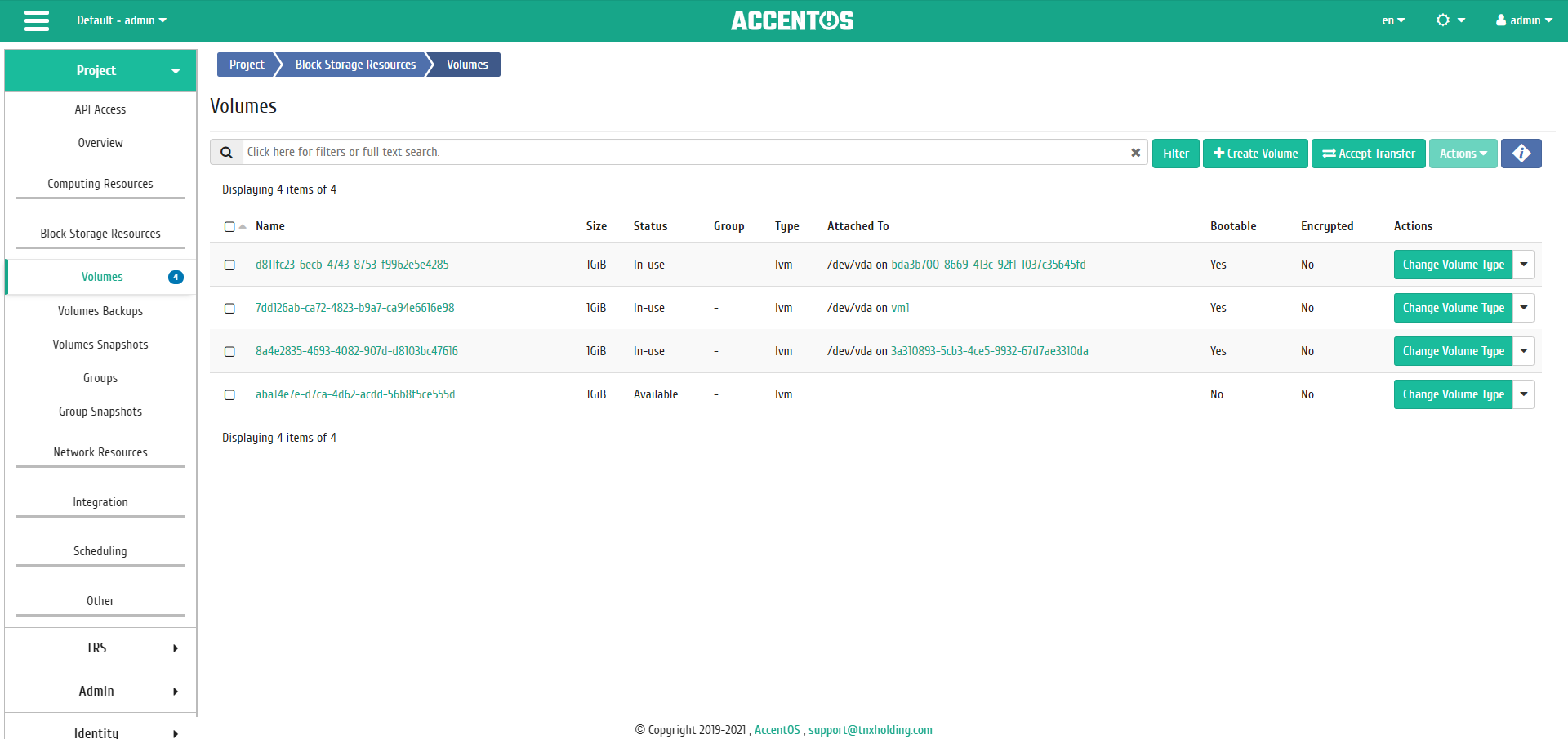
Volumes list¶
| Field name | Description |
|---|---|
| Name | Volume name assigned by the user upon creation. Also it can be changed in the general list and it is a link to go to the detailed specific volume information. |
| Size | Displaying information about the amount of volume resources. |
| Status | Displaying the status of the volume. Possible values are:
|
| Group | Volume group that this volume belongs to. |
| Type | Volume type. |
| Attached To | It displays information about the instance and the mount point to which this volume is connected. Clicking on the instance name you will go to the detailed information tab of the instance. |
| Bootable | Flag displays the ability to load the volume when starting the instance to which the volume is connected. It changes in the general list. |
| Encrypted | Flag displays whether the volume is encrypted. Clicking on the flag in new window will display detailed information. |
Sorting and filtering tools are available for volumes list. Fields are sorted in ascending and descending order. It is also possible to sort the objects marked with a check mark. Filtration is performed according to the following parameters:
- Name is the name of the volume. Incomplete name entry is possible;
- Size is the amount of volume resources. Incomplete name entry is possible;
- Status is volume state. Incomplete name entry is possible;
- Group is group of volumes to which this volume belongs. Incomplete name entry is possible;
- Type is type of volume. Incomplete name entry is possible;
- Attached To, information about the instance and the mount point to which this volume is connected. Incomplete name entry is possible;
- Availability Zone is availability zone of volume. Incomplete name entry is possible;
- Bootable is indication that the volume can be used when starting instance. Incomplete name entry is possible;
- Encrypted is indication that volume is encrypted. Incomplete name entry is possible;
- Minimum Size (GiB) is minimum value for volume size. Incomplete name entry is possible;
- Maximum Size (GiB) is maximum value for volume size. Incomplete name entry is possible.
Also, the user can view detailed information about volume. Detailed information about the object opens in a separate block on the right side of the page when you click on the volume name link. This does not close the list of objects and is displayed on the left side of the page. To close block of detailed information use the  button, to open a block of detailed information use the button
button, to open a block of detailed information use the button  .
.
«Overview» tab¶
This tab displays detailed information about the selected volume:
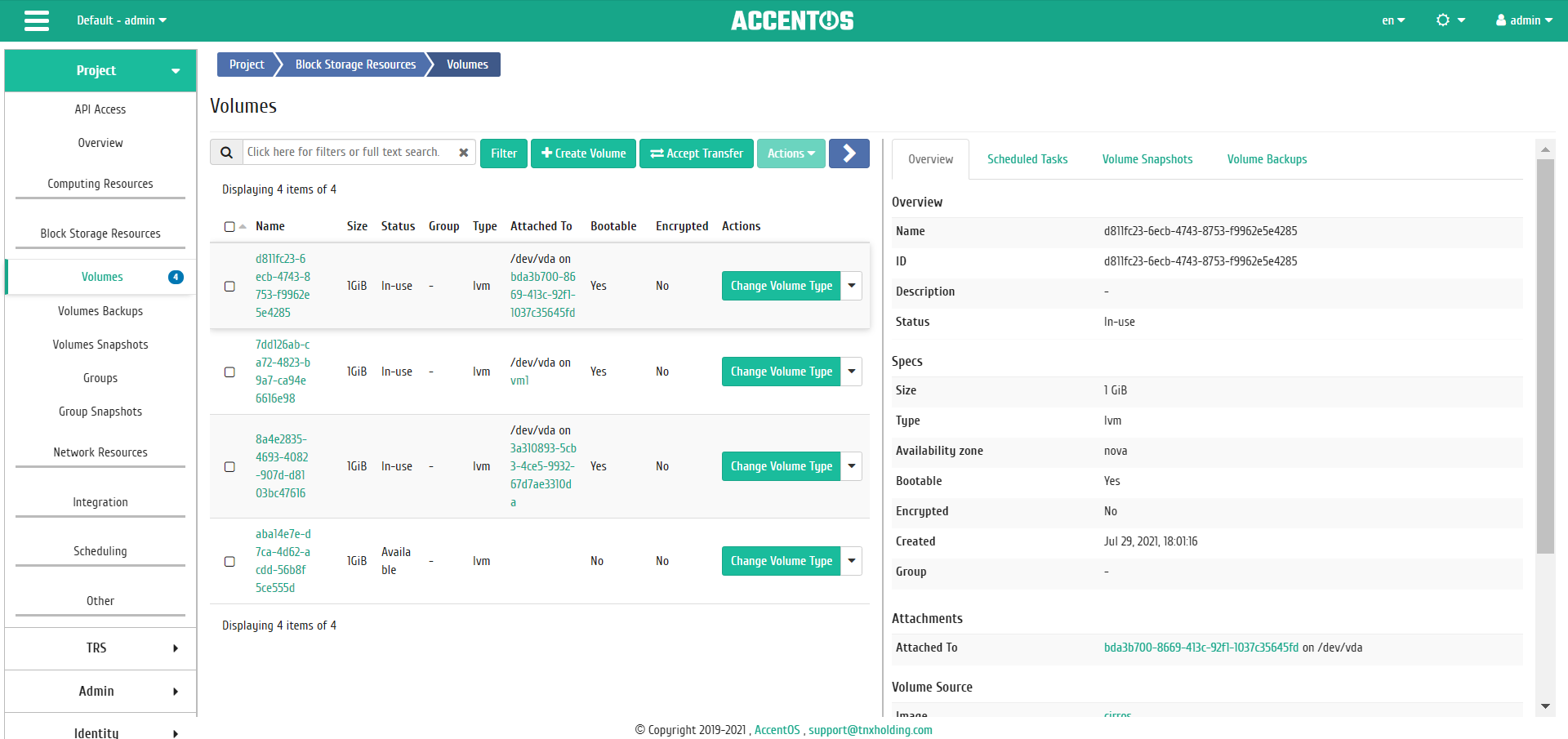
Detailed volume parameters¶
The page displays:
- General information: volume name, description, id and status;
- Attachments: list of instances to which volume is connected;
- Metadata, list of volume metadata;
- Specification, detailed characteristics of the volume;
- Locking, displayed if the volume has general or individual lock, and indicates the host or list of hosts on which the volume is locked;
- Physical Volumes List (PV) is list of physical volumes on which the logical volume is located;
- Group is group of volumes to which this volume belongs.
Note
Names of the instances to which the volume are connected are references to the data pages of the objects. This allows to navigate directly to the desired instance, bypassing the process of searching and switching between tabs. When you open links in a new tab/window, in addition to going to the details of the instance, the corresponding section of the main menu opens.
«Scheduled Tasks» tab¶
Tab displays list of scheduled tasks:
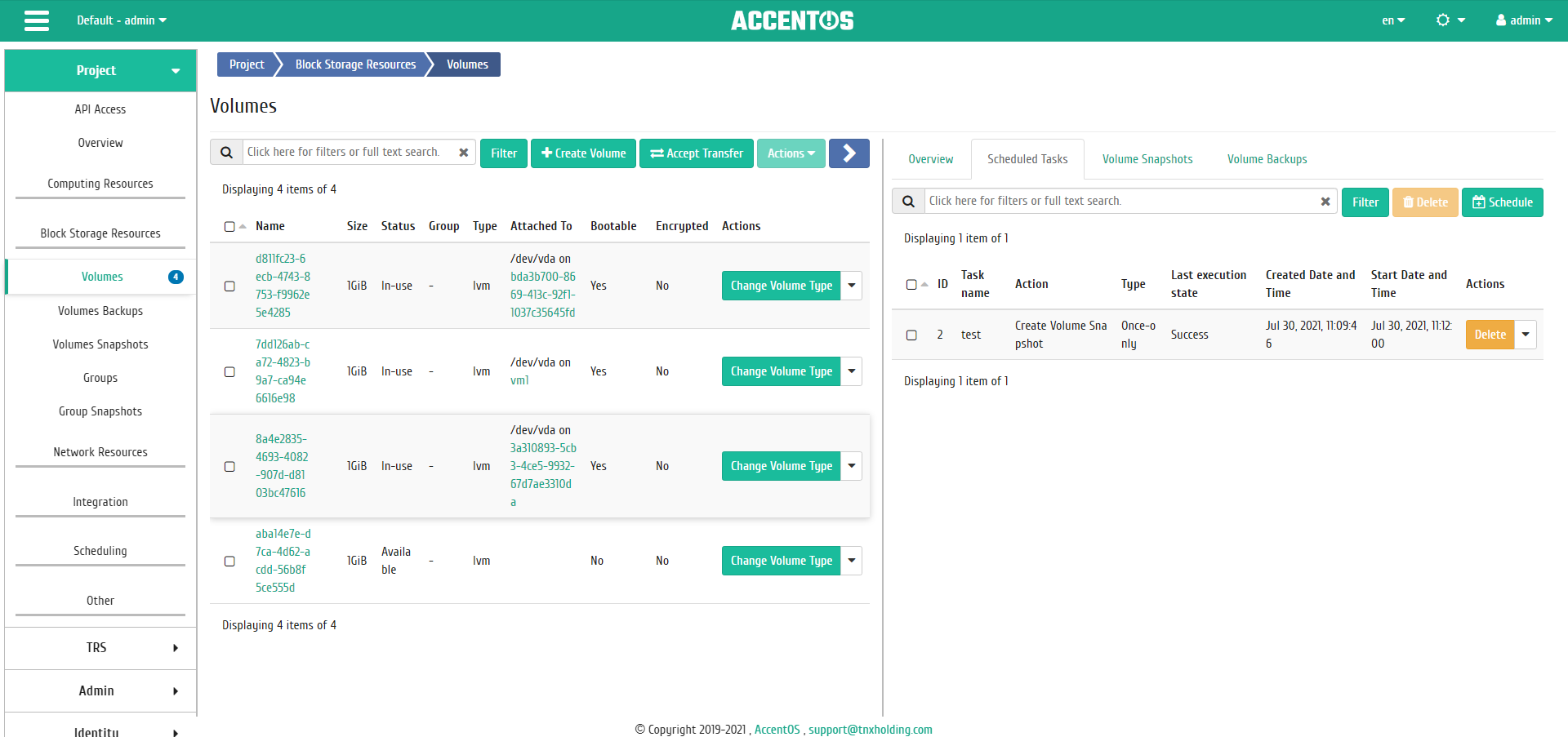
List of scheduled tasks¶
Sorting and filtering tools are available for the list of instances. The fields are sorted in ascending and descending order. It is also possible to sort the objects marked with check mark. Filtration is performed according to the following parameters:
- ID is task identification number. Incomplete input is allowed;
- Task name is name of task. Incomplete input of name is allowed;
- Action is name of action. Incomplete input is allowed;
- Type is the type of task execution. Only exact input is allowed;
- Last execution task is task execution status. Incomplete input is allowed.
On the page you can also see detailed information about each task. All actions are described in more detail in the «Scheduled Tasks» tab.
On the tab there is button “Schedule”, when you click on it, you go to the form for scheduling task on the object.
«Volume Snapshots» tab¶
Tab displays list of volume snapshots:
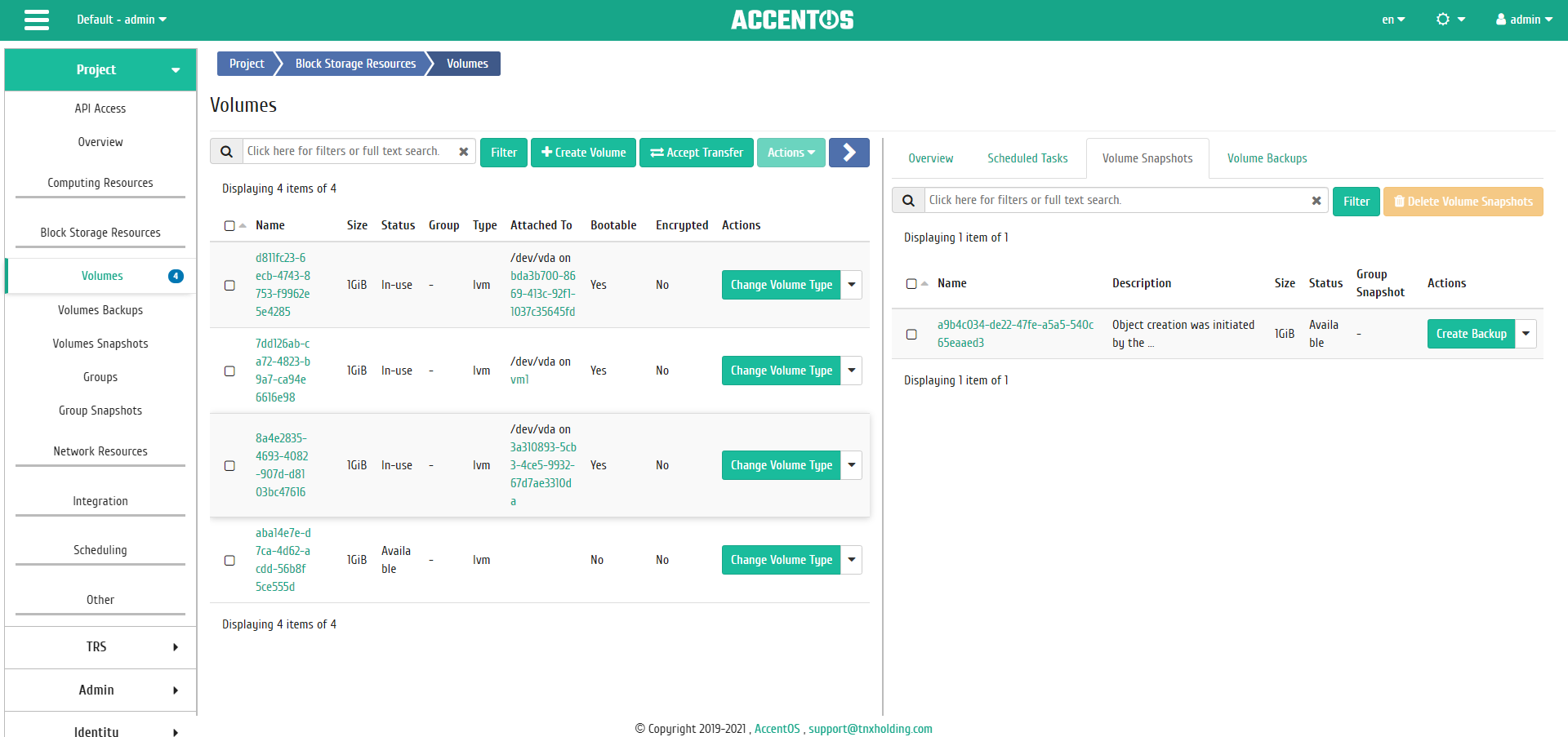
Volume snapshots list¶
| Field name | Description |
|---|---|
| Name | Snapshot name can be specified by the user. It is also link to go to the detailed information of the selected volume snapshot. |
| Description | Brief information about snapshot. This field is optional, filled in when creating snapshot. User can change the field value, using action Edit snapshot. |
| Size | Volume snapshot resource information. |
| Status | Snapshot status information. Following statuses are possible:
|
Sorting and filtering tools are available for the list of volumes snapshots. Sorting is available for all fields. It is possible to sort the objects marked with a check mark. Filtering tool works by the name of any of the fields, incomplete input of the name is possible.
| N | Action | Description |
|---|---|---|
| 1 | Launch as instance | Launching instance from selected snapshot. |
| 2 | Update metadata | Managing volume snapshot metadata. |
| 3 | Edit snapshot | Snapshot name and description changes. |
| 4 | Create volume | Creating volume from snapshot. |
| 5 | Create backup | Creating volume backup from snapshot. |
| 6 | Delete volume snapshot | Deleting volume snapshot. |
«Volume Backups» tab¶
Note
«Volume Backups» tab is only displayed when the value of parameter enable_cinder_backups is True in Dashboard module configuration file.
Tab displays list of volumes backups:
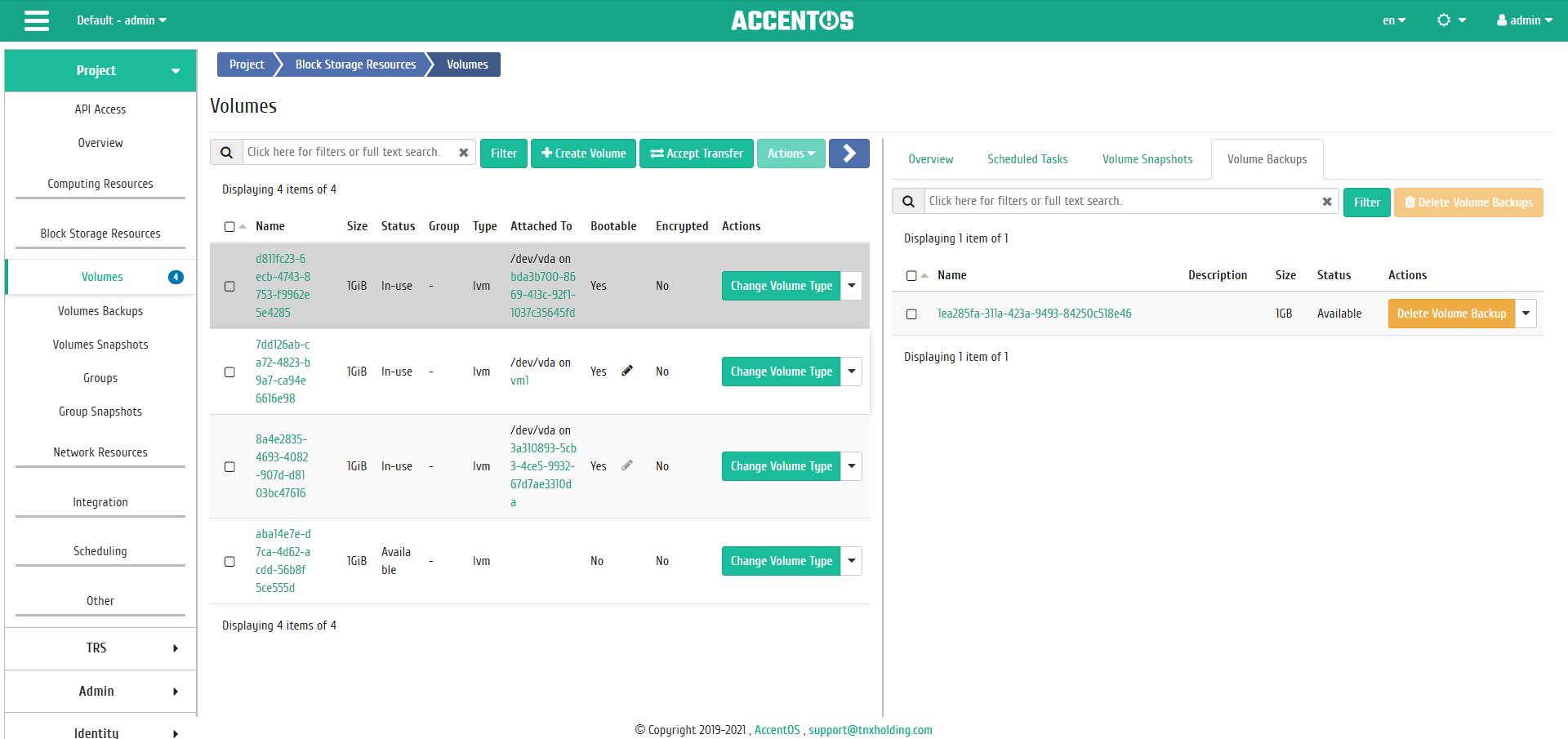
Volume backups list¶
| Field name | Description |
|---|---|
| Name | Name of the volume backup can be specified by the user arbitrarily. It is also a link to go to the detailed information of the selected volume backup. |
| Description | Brief description of volume backup. |
| Size | Size of volume backup. |
| Status | Status of the volume backup. |
Sorting and filtering tools are available for the list of volumes backups. Sorting is available for all fields. It is possible to sort the objects marked with a check mark. Filtering tool works by the name of any of the fields, incomplete input of the name is possible.
| N | Action | Description |
|---|---|---|
| 1 | Restore Volume Backup | Data recovery is available both with the existing volume and with the creation of new one. |
| 2 | Delete Volume Backup | Deleting volume backup. |
| N | Action | Description |
|---|---|---|
| 1 | Create volume | Adding volume with certain parameters. |
| 2 | Upload to image | Creating image of volume. Volume is being loaded to image service as image. It lets you subsequently run the created volume image as instance. |
| 3 | Schedule | Execution of the selected action on the volume at specified point in time. It is also possible to repeat the action after a certain period of time. Scheduling is only possible if there are available actions. |
| 4 | Launch as instance | Launching instance from selected volume. |
| 5 | Change volume type | Changing volume type. |
| 6 | Migrate LV | Moving logical volume from the current physical volume to the selected one. |
| 7 | Update metadata | Managing volume metadata. |
| 8 | Accept transfer | Action is available on the top panel. It allows to accept a previously created transfer for the required project. To accept the transfer, you must obtain the transfer ID and the authorization key from the donor project. |
| 9 | Extend volume | Changing volume size. |
| 10 | Edit volume | Editing general parameters of the volume such as: name, description and the «Bootable» flag. |
| 11 | Make mirrored volume | Converting volume from standard to mirrored. Not available for flag «Thin» volumes. |
| 12 | Make standard volume | Converting volume from mirrored to standard. Not available for flag «Thin» volumes. |
| 13 | Create transfer | Transferring volume from one project to another. |
| 14 | Create volume backup | Creating volume backup. Action is also available for volumes attached to instances. |
| 15 | Create snapshot | Creating snapshot of instance memory. Snapshot of volume is used to create copy of volume and the possibility of its subsequent launch as instance. |
| 16 | Delete volume | Deleting volume. Action is not possible if snapshot of volume exists. In this case, you must first delete the snapshot. When deleted, all tasks scheduled for it are deleted along with the volume. Also, deletion is not available for volumes included in groups or attached to instances. |
| 17 | Manage Attachments | Attachment to the selected volume of the instance. |
Actions are available for execution with respect to one selected volume by calling the required action in the “Actions” field of the corresponding line in the list of all volumes.
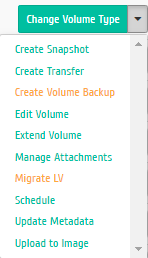
Individual actions on volume¶
Actions to create or transfer volume are available on top bar of the page.
You can also perform actions on a group of pre-selected volumes. To do this, you need to mark the required volumes and select group action:
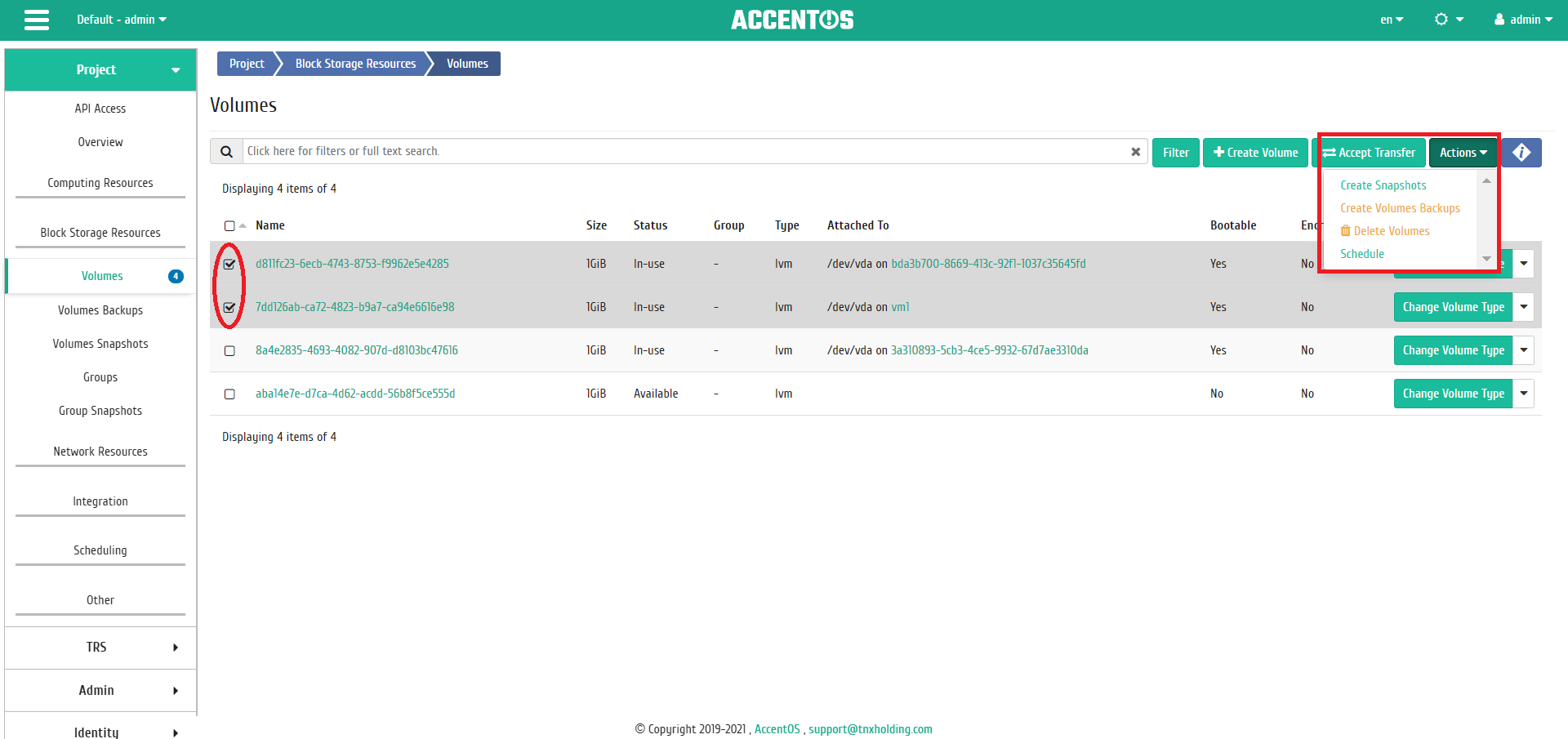
Group actions on volumes¶
In addition, actions on volume or volumes group can be scheduled to take place at specific point in time.
To schedule an action for one volume, you must select «Schedule» in the action list:
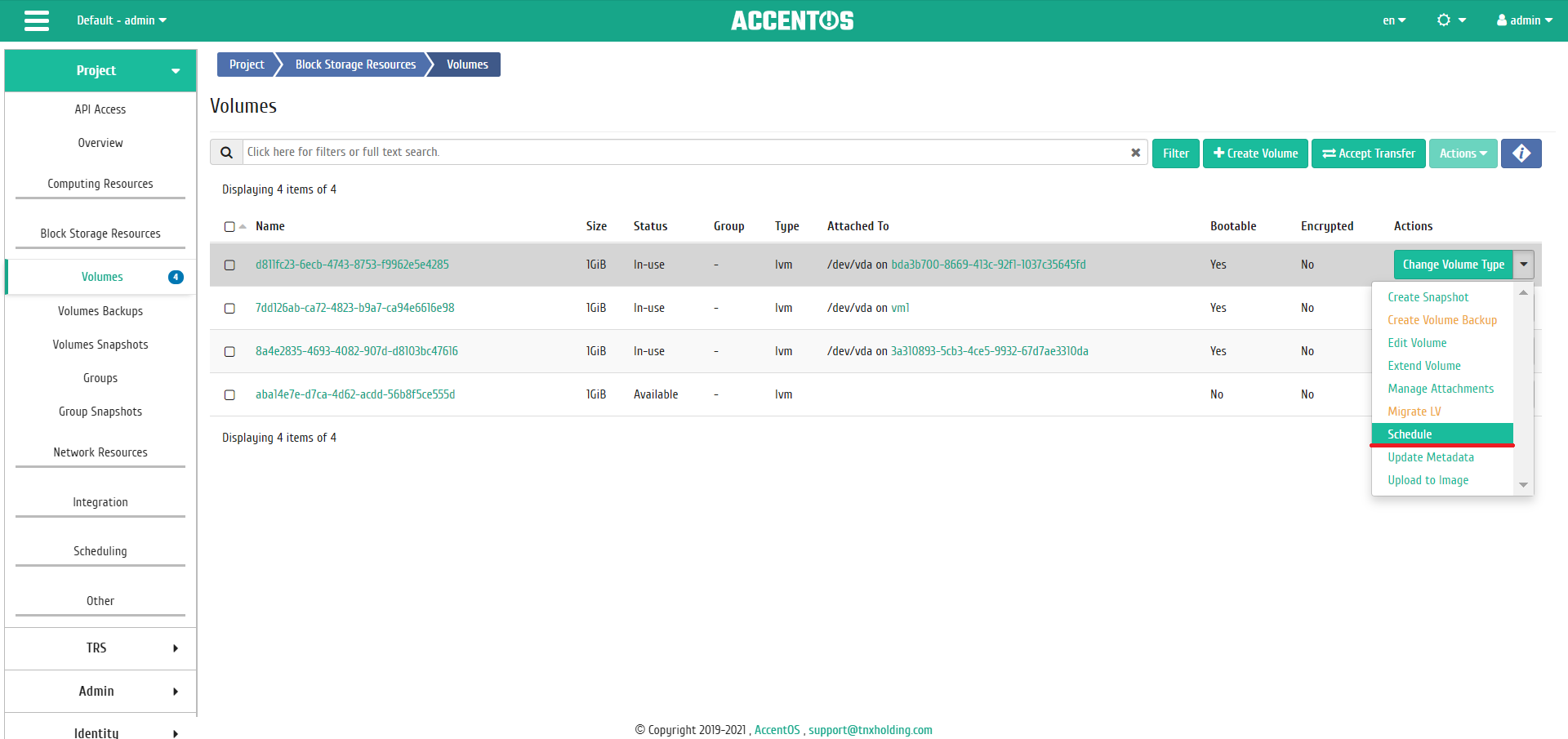
Scheduling for single volume¶
When scheduling task for a group of volumes, you must mark the required volumes and select group action «Schedule»:
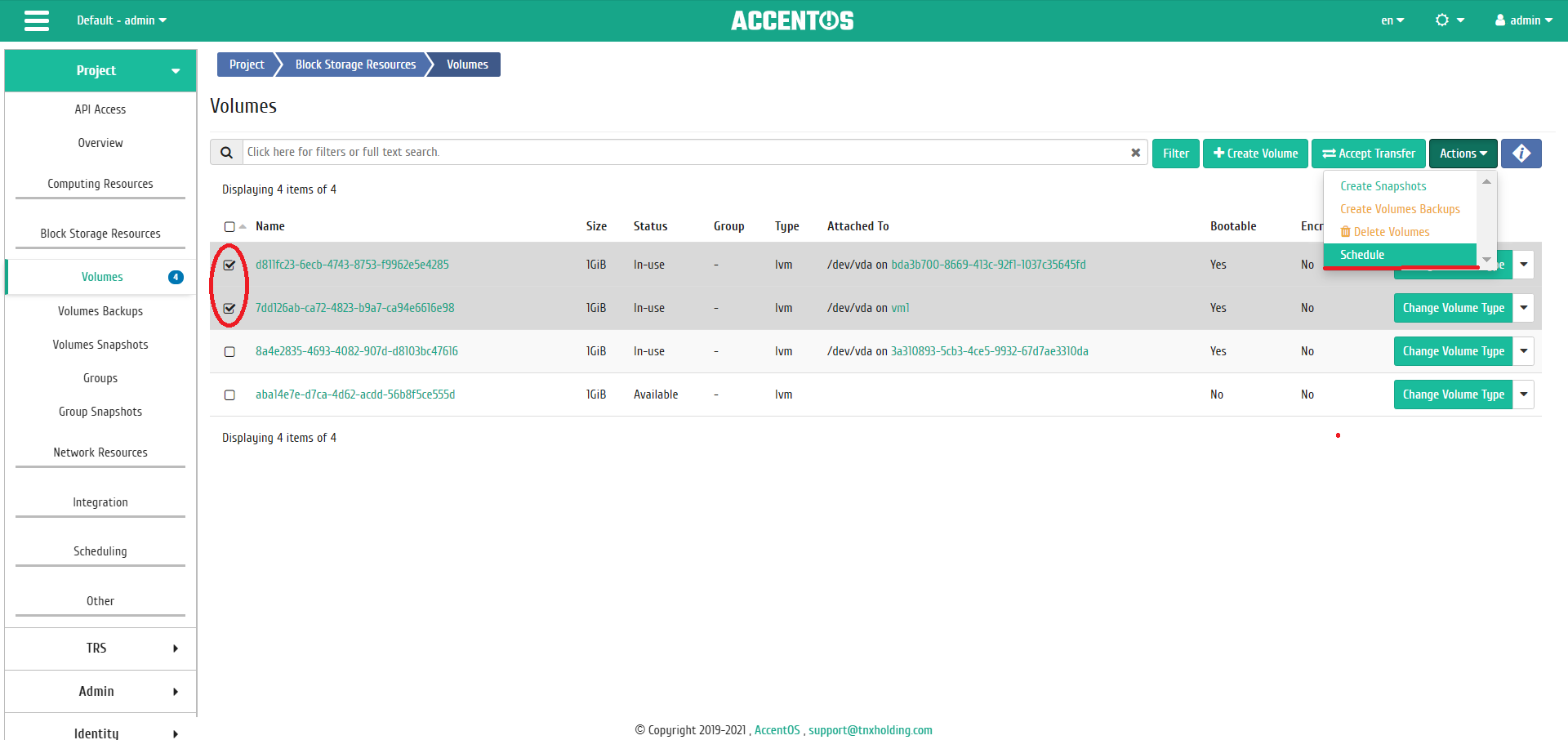
Scheduling for volumes group¶
Features of working¶
- Creating volume
- Volume image creating
- Volume snapshot creating
- Volume backup creating
- Launching instance from volume
- Migration LV
- Convertation to mirrored volume
- Convertation to standard volume
- Changing volume type
- Volume extending
- Volume transfer start
- Volume transfer acceptance
- Volumes attachment management
- Scheduling actions on volume
Creating volume¶
In general list of all volumes on control panel open volume creation wizard clicking «Create volume»:

Creating volume window¶
In window that opens, indicate:
- Volume name is an optional field, if the value is empty, the name is generated automatically;
- Description is optional field;
- Volume source, select the type of boot source;
- Type, select of a ready-made volume template. Type editing is described in the «Volume types» tab;
- Size is the amount of volume storage in gibibytes;
- Availability zone, choice is made based on the need for certain resources;
- Group, select group to which the created volume will belong;
- «Thin Volume» Flag, when choosing flag, «Thin provisioning» technology is used, which allows to use the free volume space for other needs of project.
Follow the directions, choosing options based on amount of resources available. We complete creation procedure with the «Create volume» button. After that, the correctly created volume will be displayed in the general list. Otherwise, the system will return you to the wizard window indicating the reasons for the impossibility of its creation.
After the successful creation procedure is completed, the volume may take time to finalize all systems. Ultimately, volume is displayed with the status «Active».
Volume image creating¶
This function allows to load volume to image service as an image. It is available in general list. After calling the action in the window that opens, set the name and format of the image.
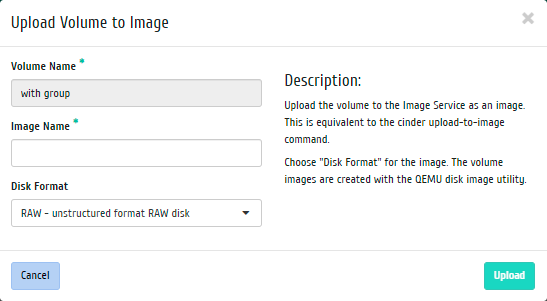
Volume image creating window¶
Created image is displayed in the tab “Images” with the “Active” status.
Volume snapshot creating¶
Action is available in the general list. After calling the action, you will be prompted to specify the name and description of the snapshot; the fields are optional. If the value is empty, the name will be generated automatically.
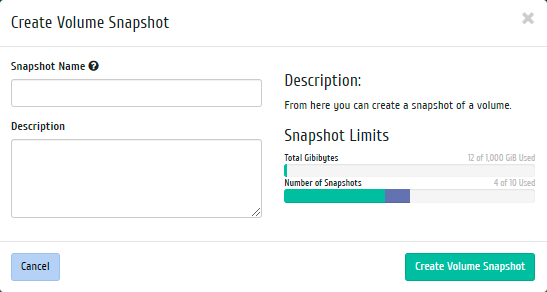
Volume snapshot creating window¶
Confirm the snapshot creation, after which the snapshot will be displayed in the tab “Volume snapshots” with the “Available” status.
Volume backup creating¶
Action is available in the general list. After calling the action, you will be prompted to specify the name and description of the backup; the fields are optional. If the value is empty, the name will be generated automatically.

Volume backup creating window¶
Confirm the backup creation, after which the backup will be displayed in the tab “Volume backups” with the “Available” status.
Launching instance from volume¶
Function is available in the general list. It allows to create instance using the selected volume. The creation procedure is described in more detail on the page “Launching instance”.
Migration LV¶
Function provides the ability to migrate data for alogical volume on active system from current physical volume to selected one. This function is available in individual volume actions. Select the required volume and call “Migrate LV”:
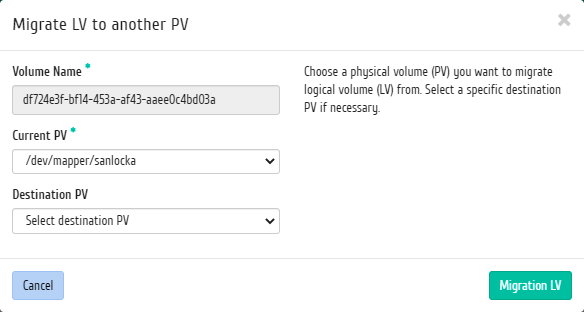
Logical volume migration window¶
Select physical volume from the list of available ones for transfer and click «Migrate LV».
Important
Specifying the physical volume to transfer is optional. In this case, the transfer will be carried out to the automatically selected.
Convertation to mirrored volume¶
Note
Action is not available for volumes with the «Thin Volume» flag.
Function allows to convert standard volume to mirrored one. Mirroring technology allows to protect data in the event of a possible failure of physical disk, by saving multiple copies of files. This type is useful for protecting sensitive data in the event of possible hardware failures. This function is available in individual volume actions. Select the required volume and call “Make mirrored volume” action:

Confirmation window for converting to mirrored volume¶
After confirmation, the volume will be converted to mirrored. You can see the type of logical volume on the page with detailed information, in the tab “Overview”.
Convertation to standard volume¶
Note
Action is not available for volumes with the «Thin Volume» flag.
Function allows to convert mirrored volume to standard one. This function is available in individual volume actions. Select the required volume and call “Make standard volume” action:

Confirmation window for converting to standard volume¶
After confirmation, the volume will be converted to standard. You can see the type of logical volume on the page with detailed information, in the tab «Overview».
Changing volume type¶
Function allows to edit type and migration policy of the selected volume. It is available in the general list of all volumes. After calling the action in the window that opens, set the necessary parameters:
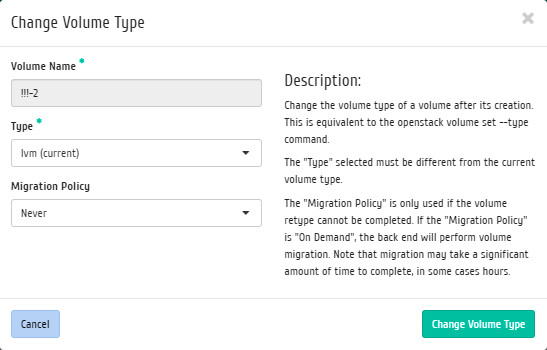
Changing volume type window¶
End the procedure with the confirmation button.
Volume extending¶
Function allows to resize the selected volume within the allocated project quota. You can resize both a volume that is not attached to the instance with the “Available” status, and a attached one with “In-use” status. After calling the action in the window that opens, set the required size:

Volume resizing window¶
End the procedure with the confirmation button.
Volume transfer start¶
Volume can be transferred from one project to another. The function is available in the general list of all volumes. After calling the action, you will be prompted to set the name of the volume transfer, the field is not required to be filled in, and if the value is empty, it will be generated automatically.
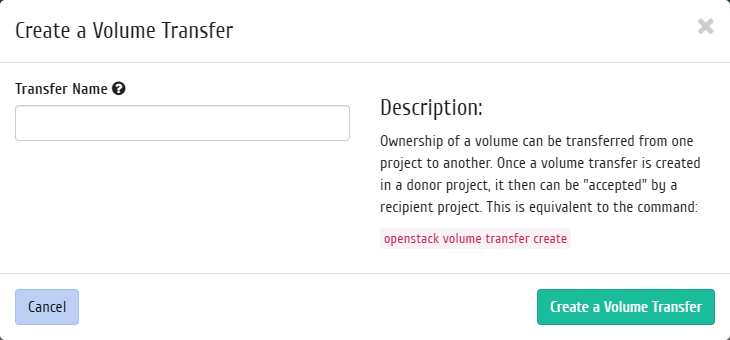
Volume transfer creation window¶
Then you need to save the ID and authorization key of created transfer:
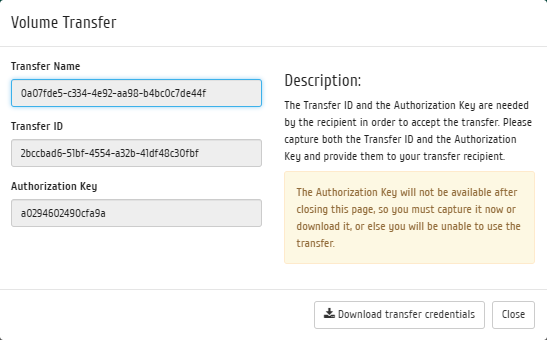
Volume transfer details¶
End the procedure with the confirmation button.
Volume transfer acceptance¶
Note
It is possible to accept the transfer of the volume only if the ID and the authorization key of the previously created transfer are available.
Function is available on the control panel in the general list of all volumes. After calling the action in the opened window, specify unique data:
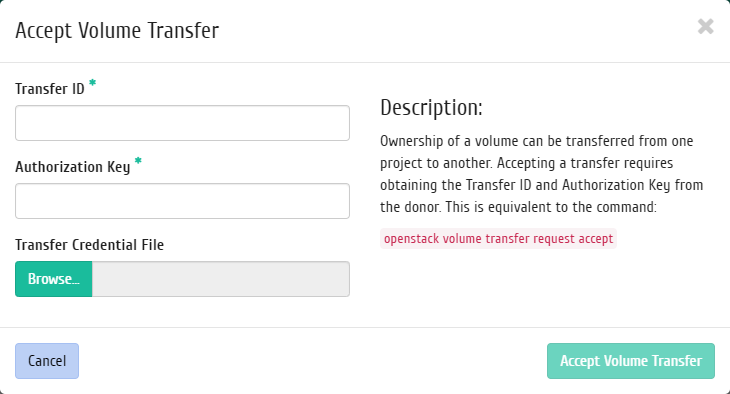
Volume transfer acceptance window¶
Such as:
- Transfer ID;
- Authorization key.
You can also load the volume transfer credentials from the file obtained during the transfer creation step. We finish the procedure with the confirmation button. Then the volume will be displayed in the general list. Otherwise, the system will return you to the wizard window indicating the reasons for the impossibility of accepting the transfer of the volume.
Volumes attachment management¶
Function is available in the general list of all volumes. If there are instances in the project, it allows you to control the attachment of the selected volume to the instance:

Volumes attachment management window¶
You can select available instance in the list by one of the parameters:
- Name;
- IP address;
- Type;
- Status;
- Zone;
- Direct SCSI.
Note
When attaching volume to the instance with Direct SCSI sending SCSI commands to the volume will be done directly, bypassing the hypervisor.
Sorting and filtering tools are implemented for each of parameters. It is also possible to sort the objects marked with check mark.
Also, depending on volume type, it is possible to connect the volume to multiple instances. The multi-mount volume type setting is described in the Administrator/Block Storage Resources/Volume Types section.
The required instance is attached using button «↑». To detach instance use «↓». End the procedure with the confirmation button.
Scheduling actions on volume¶
Select the required volume and call the action:
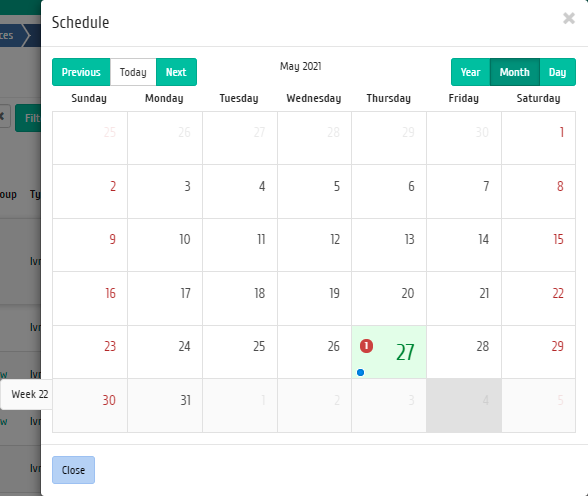
Scheduled action calendar¶
In the wizard window that opens, select the date. Highlighted days indicate the presence of planned actions on this object for the date, and blue marks indicate their number.
To go to the next step in the field of the selected date, click on an empty area or number. In the first case, you will be redirected to the task creation window. When you click on the number, you will be immediately prompted to select the duration:
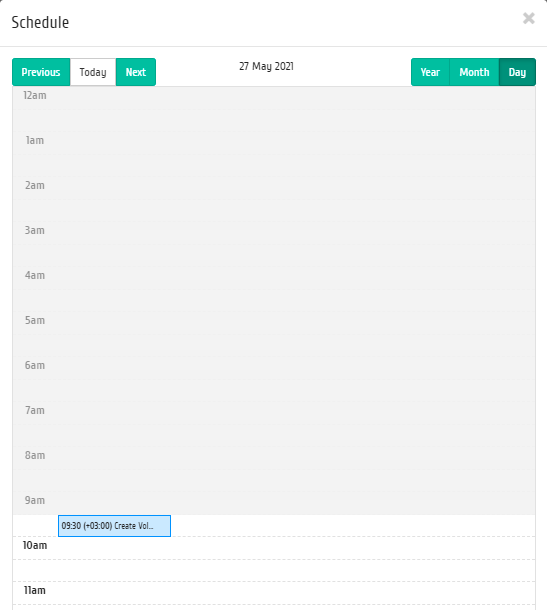
Scheduled action calendar¶
Specify the rest of the parameters of the scheduled action, which contain the internal tabs of the master window:
Select an action:
Task name is the name of the scheduled action; if empty, it will be generated automatically;
Action is list of available actions on the volume:
- Create volume backup;
- Create volume snapshot;
- Run openstack shell command;
- Run curl request.
More information on the available actions can be found in the corresponding section of documentation.
User credentials:
- Username is the login of the user planning the action;
- Password is password of the user planning the action;
- Project is working project of user planning the action.
Details:
- Type is the type of task. Following types are distinguished:
- Single task;
- Repeating task.
- Repeat, selection of values of the task execution interval. Following options are available:
- Days;
- Hours;
- Minutes;
- Working days (from Monday to Friday);
- Days of the week;
- Year.
- Repeat with interval, selection of task execution interval;
- Start date is the start date of the task in the format dd.mm.yyyy;
- Start time is the start time of the task in the format hh.mm;
- Time zone is the time zone according to which the task execution time is indicated;
- End is the conditions for terminating the task. Following conditions are distinguished:
- Never, when choosing a flag, the task becomes unlimited;
- Max number of repetitions is limiting the number of task executions;
- Date is the deadline for the task execution, set in the format dd.mm.yyyy.
End the procedure with the confirmation button.
Note
To return to the page with the calendar and change the date, use the “Cancel” button.
Created task is displayed in the tab «Scheduled tasks».
All available actions, not mentioned above, are performed in their master windows with prompts or have ease of management that does not need description.
